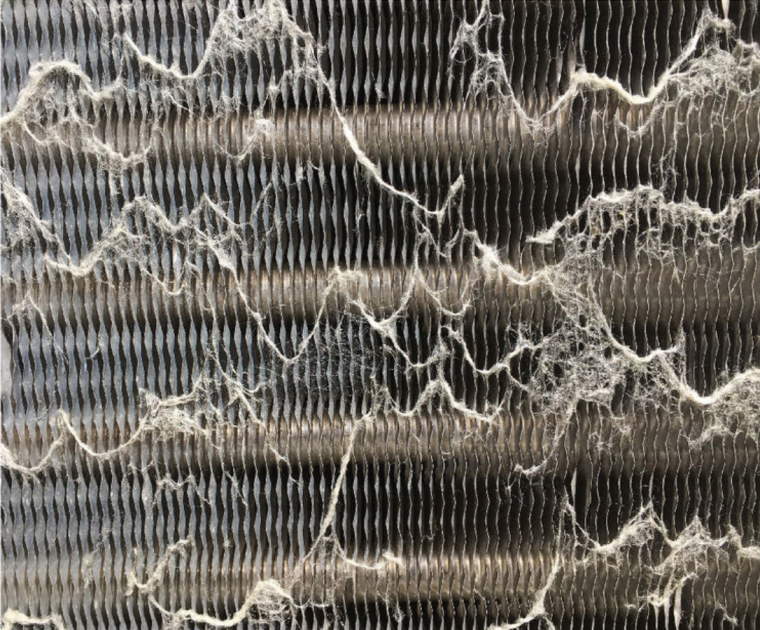Neglecting coil cleaning can be a false economy
Including coil cleaning as part of your HVAC maintenance schedule could boost energy savings
With healthcare costs escalating, hospitals across the country are continually looking for ways to streamline operations so that more pounds can be directed at patient care. HVAC plant is costly to run and a huge consumer of energy, but facilities and estate managers could use up to 30% less energy by simply including coil cleaning as part of their planned, preventative maintenance programme.
How much do dirty condenser coils cost your hospital? No idea? You are not alone. Condenser coil cleaning is one of the most overlooked maintenance jobs. The dirtier the coils get, the more they increase the compressor’s energy consumption whilst reducing the ability to transfer heat, put additional stress on components and increase the likelihood of premature failures and costly repair bills.
One of the easiest and most cost-effective tasks that can be carried out to maximise energy efficiencies of your chiller plant is to have the condenser coils inspected regularly and cleaned when necessary. Clean coils can impact energy efficiencies and affect the longevity of your HVAC systems and compromise internal environments. All too often coil cleaning gets overlooked or postponed as part of cutting back on maintenance bills. But such false economy could cost you dearly.
When it comes to managing your buildings assets, planned preventative maintenance is a key element and the best way to ensure optimal performance, and protect the longevity of your HVAC plant whilst staving off failures. Yet all too often cleaning the coils on air cooled chillers and condensers are disregarded in a bid to cut costs – dirty coils can increase compressor energy consumption by as much as 30%. In the long run clogged coils end up costing you more.
An ASHRAE (American Society of Heating, Refrigeration and Air Conditioning Engineers) study showed that cleaning coils as part of good maintenance practice could improve energy efficiencies by as much as 10-15%.
But it is not just old systems that need cleaning. Chiller efficiencies have improved considerably thanks to advances in technology, but systems with higher SEER ratings lose much of their effectiveness when forced to run harder than is necessary, so the newer and more efficient your HVAC system, the more it will benefit from regular inspections and a cleaning programme.
With rising costs and increasing demands on equipment, no estates manager can afford to ignore coil cleaning which could lead to an unpleasant spike in energy bills and comprise the overall performance level of your chiller system.
All too frequently coil cleaning is not part of a PPM contract points out Paul Osborne, Service Manager at Aermec:
“PPM engineers are typically concerned with the overall running of the plant and more specifically the mechanical and electrical aspects and cuts in maintenance contracts mean that coil cleaning is either not specified or postponed to reduce their costs.”
“There’s no getting away from the fact that coils do get dirty and are often in areas difficult to access. The job is very labour intensive, can be unpleasant and requires a specific skill set to address safety issues and prevent any damage particularly to the fins.”
But is cleaning coils really that important and should you call in the experts? Absolutely, as Paul Osborne explains:
If left, over time the surface of the coils will build up with contaminants and have an insulating effect which will decrease the available surface area for heat transfer and lead to excessive energy consumption, poor system performance and shorten the life of your equipment.
“HVAC plant is a huge investment for any hospital and year-round optimal performance is essential.”
Chillers draw in substantial amounts of air over the coils, which are at the point where the heat transfer takes place. Coils can all too easily become caked in assorted contaminants from dust particles, general dirt from the atmosphere, vegetation and pollen resulting in the climate. Salt laden environments add their own unique set of problems including sea gull droppings!
Equipment failure
Condenser coils are exposed to unfiltered air and will accumulate debris and other contaminants at a predictable and consistent rate. when the coils get dirty the compressors have to work that much harder to produce the same amount of cooling and clogged coils can cause many problems including:
- Compromise heat transfer
- Reduce cooling capacity
- Increase energy usage
- Damage components
- Reduce energy efficiency
- Reduce longevity of the system
If left unchecked for substantial periods and detritus is allowed to build up, equipment could eventually fail leading to costly downtime. Dirty coils can also have a more human impact. Compromised cooling equipment can affect the general discomfort of a building’s occupants, resulting in lower levels of productivity and could also compromise patient comfort.
Despite knowing the positive benefits of coil cleaning, many are rarely cleaned, cleaned poorly or irregularly allowing contaminants to build leading to corrosion and reducing coil life.
The frequency for cleaning coils varies according environmental factors. In the UK for example, cleaning is recommended after the pollen season is finished. Pollen fibres can quickly build up and become matted. Twice yearly cleaning is recommended for most sites, hospitals cannot afford any interruption or denigration of their facilities and may require more frequent attention. Awareness of the coil’s environment and experience will help determine the right cleaning schedule.
Although some companies have tried cleaning coils themselves to reduce maintenance costs, it is best left to the experts. The use of high pressure washers for example, can do more damage than good as the excessive pressure can easily damage coil and lodge the dirt deeper within the tightly packed fins, making it more difficult to remove. Fluids incorrectly applied can also lead to corrosion and/or safety issues.
Clean coils are essential to maintain optimal efficiency and should be included as part of your overall asset management strategy. Many manufacturers can offer a variety of service and maintenance packages, including coil coating as an option depending on the site and application.
But don’t forget to pay attention to other components. Upgrading condenser and AHU fans can achieve further efficiencies. Instead of buying new kit, upgrades can potentially save money and energy too. EC fans offer the same output as AC fans for less input and consume 70% less energy. By installing EC fans, airflow is improved and significant energy savings can be achieved.
A site survey will identify the right programme for your plant and recommend appropriate upgrades and/or replacements to optimise performance.
As with any mechanical system it is important to follow the manufacturers recommendations for maintenance to ensure peak performance. Regular coil cleaning is important to promote longevity and high operating efficiencies. Unexpected repairs, downtimes and lower maintenance bills can be the direct result of coil cleaning. Weighing up the cost and benefits of cleaning will enable you to work out a cost/benefit ratio for cleaning in the future and keep the finance director happy.
So, when was the last time coils were cleaned at your site?
The article published in Health Estate Journal (October 2019)

